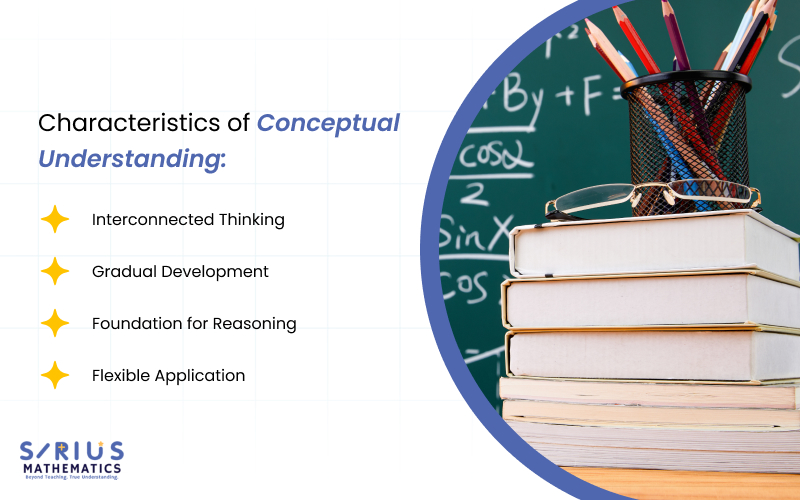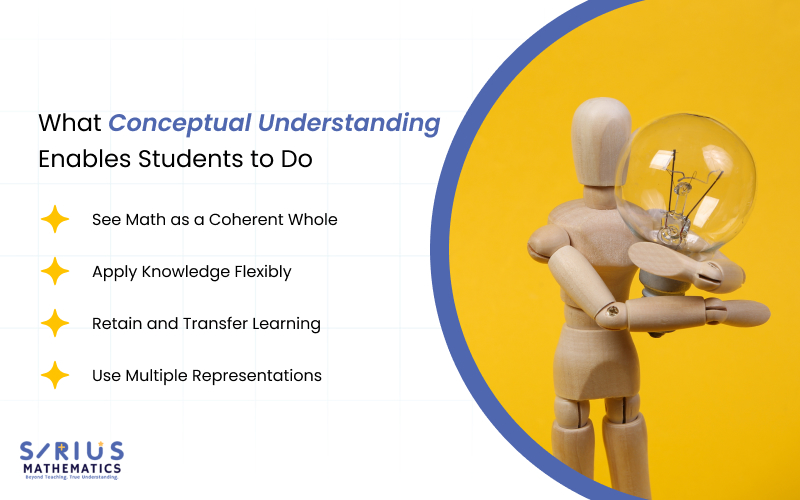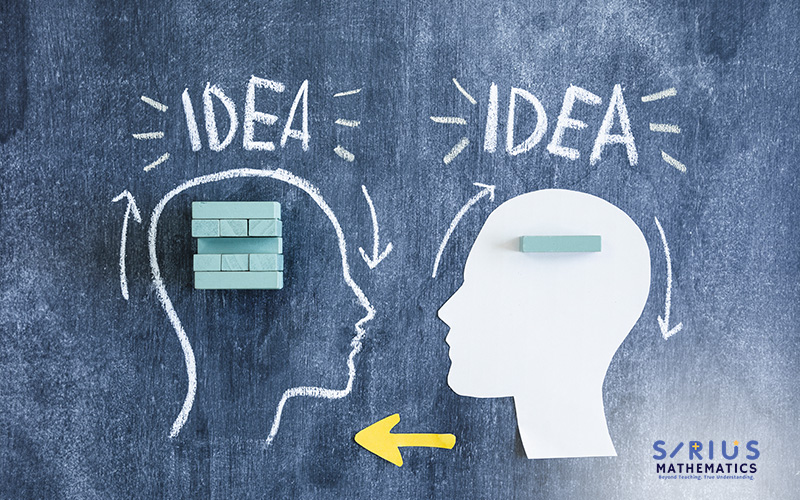Introduction
Many students struggle with mathematics even after putting in hours of practice and completing countless worksheets. What they often don’t realise is that the real challenge lies not in how much they practise, but in how well they understand what they’re doing. While procedural fluency, or knowing the steps to solve a problem, is important, it only tells half the story.
The truth is that mathematical success comes from conceptual understanding—the ability to grasp the underlying principles behind the methods. In Singapore’s MOE-aligned curriculum, there is a strong emphasis on problem-solving, reasoning, and analytical thinking, all of which depend on this deeper level of understanding.
In this article, we explore what conceptual understanding means and why it matters. Let’s learn how it supports long-term confidence and success in math.
Key Takeaways:
- Why Is Conceptual Understanding Essential for Math Success?
The true success in math isn’t just about memorising steps—it’s about knowing why those steps work. When students grasp the meaning behind mathematical ideas, they can approach problems logically, adapt their methods when needed, and to apply what they’ve learned to different situations.
- How Does Conceptual Mastery Benefit Students in the Long Run?
Students who build deep insight into mathematical relationships retain information better and are more prepared to handle complex, unfamiliar problems. They develop critical thinking skills, become more resilient learners, and are better equipped for higher-level math and real-world applications. Over time, this foundation supports stronger performance across academic levels.
- What Makes Conceptual Understanding So Important in Singapore Math?
Singapore’s math curriculum focuses heavily on reasoning, application, and analysis. Students are expected to solve non-routine problems, explain their thinking, and apply knowledge across different topics. To meet these demands, learners need to truly make sense of what they’re doing.
Overview of Conceptual Understanding
What Is Conceptual Understanding in Maths?
Conceptual understanding in mathematics is about knowing why a method works rather than just how to apply it. Instead of just relying on rote memorisation, students with strong conceptual understanding grasp the logic and principles behind mathematical procedures. This depth of knowledge enables them to see how different ideas connect and apply what they’ve learned to a wide range of problems.

Let’s take a look at the characteristics of conceptual understanding:

1. Interconnected Thinking
Students recognise the relationships between concepts. For instance, how fractions relate to division or how area formulas build on multiplication.
2. Gradual Development
Conceptual understanding takes time. It is reinforced through varied experiences, discussions, and hands-on learning—not a single lesson or topic.
3. Foundation for Reasoning
It lays the groundwork for strong problem-solving by helping students understand how to approach unfamiliar questions with clarity and logic. With this foundation, they can reason through complex scenarios, adapt strategies when needed, and tackle challenging problems confidently.
4. Flexible Application
Students with conceptual understanding can adapt their thinking when presented with new or complex problems. Thanks to their deep comprehension of the principles behind the methods, they can apply their knowledge flexibly across different contexts.
Conceptual vs. Procedural Understanding: How Do They Differ?
While procedural fluency vs conceptual understanding are often mentioned together, they play very different roles in a student’s development. Procedural fluency refers to the ability to perform mathematical reasoning and application efficiently. On the other hand, conceptual understanding is about mastering the ideas behind those steps.
In this section, we explore what each approach involves and why striking the right balance is key to long-term success in mathematics.
1. Procedural Fluency
This refers to knowing how to carry out a specific process or set of steps accurately and efficiently. It’s essential for speed and accuracy in routine problems.
Example: A student memorises the formula for the area of a triangle and applies it correctly every time. However, they may not know why the formula works or where it comes from. Relying solely on procedures can lead to confusion when problems are presented in unfamiliar ways.

2. Conceptual Understanding
This goes deeper. It involves understanding the reasoning behind procedures and seeing how they fit into the larger framework of mathematics.
Example: A student understands that the formula for the area of a triangle (½ × base × height) is derived by imagining a triangle as half of a rectangle. This insight helps them apply the concept to irregular shapes, composite figures, or word problems effectively. With the right math tutoring support, students can develop this kind of deep understanding through guided explanations and targeted practice.
Why the Difference Matters
Students who rely only on procedural skills may do well in straightforward practice exercises or routine questions. However, when they face unfamiliar or multi-step problems, especially in PSLE Math Paper 2, they often struggle. This is because such questions are designed to test deeper thinking and the ability to apply knowledge in new situations, not just recall procedures.
On the other hand, students with strong conceptual understanding can break down complex problems. This allows them to think critically about what is being asked and choose appropriate methods based on logic rather than memorisation. That said, they are far more prepared to tackle the kinds of non-routine, real-world questions commonly found in Singapore’s math curriculum.

Why Conceptual Understanding Matters in the Singapore Math Curriculum
As students progress in their math journey, practising alone is no longer enough. The Singapore Math curriculum places increasing emphasis on higher-order thinking. Singapore’s Assessment Objectives (AO1 to AO3) are structured to assess more than just accuracy in computation. They focus on reasoning, applying concepts in new contexts, and demonstrating metacognitive awareness. Without a firm conceptual base, students often struggle to meet these expectations.
Where Conceptual Gaps Cause the Most Struggles?
Many students appear confident when solving familiar math problems, but quickly lose momentum when faced with something unfamiliar or slightly more complex. Often, this isn’t due to a lack of effort or practice. It actually stems from conceptual gaps.
Below are key areas where these gaps commonly cause difficulties:
1. Upper Primary Math
Topics like fractions, decimals, and ratios become confusing when students rely solely on procedures. They should first understand the relationships between parts and wholes.

2. Secondary School Math
In subjects like algebra, geometry, and graph interpretation, secondary school students must understand how variables, equations, and shapes are interconnected. Without this deeper understanding, they may struggle to apply concepts across different question types or make sense of abstract representations. To improve this, students may consider enrolling in a secondary math tuition centre in Singapore to gain academic support.
3. Applied Problem Solving
Complex word problems, mathematical modelling, and non-routine questions in exams test more than just procedural skills. They require students to think flexibly, make connections between concepts, and evaluate which methods are most suitable for solving the problem. This means students must also understand why a particular approach works in a given context.
What Conceptual Understanding Enables Students to Do

1. See Math as a Coherent Whole
Rather than viewing topics in isolation, students begin to see how different concepts connect across strands and year levels. For example, they can comprehend how ratios relate to fractions or how algebra builds on number patterns.
2. Apply Knowledge Flexibly
Conceptual thinkers are better equipped to approach unfamiliar or challenging problems with confidence. Instead of relying solely on memorised steps, they draw on their core understanding of mathematical principles to make sense of the problem. This allows them to analyse the question, identify relevant concepts, and adapt their strategies as needed.
3. Retain and Transfer Learning
When mathematical ideas are linked to meaningful relationships, students are more likely to retain them in long-term memory. This deep understanding makes it easier to recall and apply knowledge when tackling unfamiliar problems. It also lays a strong foundation for Math mastery for Singapore students, who are expected to reason, solve, and communicate effectively across different question types.

4. Use Multiple Representations
Students can express mathematical ideas in various forms, including diagrams, equations, and verbal explanations. This helps them to earn partial credit in important assessments like the PSLE, even if the final answer is incorrect. Meanwhile, for those who enrol in PSLE Maths tuition, students are often guided to explain their thought process step-by-step, helping tutors identify misconceptions and reinforce key concepts.
Teaching Strategies That Build Conceptual Understanding
How Sirius Mathematics Supports Conceptual Learning
To help students truly understand the why behind mathematical ideas, educators in Singapore often rely on a blend of proven teaching techniques. At Sirius Mathematics, our math tutors in Singapore deem conceptual clarity as the foundation of long-term mathematical mastery.
Here’s how we put these principles into action:
1. CPA Approach: From Concrete to Abstract Thinking
Widely used in MOE-aligned classrooms, the Concrete–Pictorial–Abstract (CPA) method in math learning helps students build deep understanding step by step:
- Concrete
Students begin by exploring mathematical ideas with hands-on materials such as counters, cubes, or fraction bars.
- Pictorial
Next, they translate these experiences into visual forms like bar models, part-whole diagrams, or number lines.
- Abstract
Finally, they move to symbolic representations, including equations, formulas, or algebraic expressions.
By applying CPA in both primary and secondary math tuition, we enable students to visualise mathematical relationships and connect them across topics. This structure also ensures that no student is forced to memorise procedures before understanding their meaning.
2. Encouraging Mathematical Thinking Through Explanation
During our math lessons, students are not only taught how to solve problems. In fact, we encourage them to explain why their method works. This process builds deeper understanding and strengthens critical thinking.
We employ techniques such as:
- Math Journaling
Students reflect on their thinking, explain problem-solving steps, or write about how they corrected mistakes.
- CER Framework
The Claim–Evidence–Reasoning structure helps students communicate solutions logically: What is your answer? What evidence supports it? Why does that method work?
By prompting students to articulate their reasoning, we promote metacognition—the ability to think about one’s own thinking. This reinforces internal logic and helps students develop confidence in justifying their answers.
3. Diagnostic Questioning to Identify Misconceptions
Understanding where students go wrong is as important as teaching the right methods. Instead of immediately correcting errors, our tutors use diagnostic questioning to uncover what a student was thinking when they made a mistake.
This process helps to:
- Clarify misunderstandings before they become ingrained habits
- Reveal gaps in logic, even when the final answer is correct
- Strengthen strategic thinking by highlighting alternative ways to solve the same problem
What are the Long-Term Benefits of Conceptual Mastery?
Developing conceptual understanding in mathematics paves the way for success in problem-solving, critical thinking, and lifelong learning. In Singapore’s math curriculum, conceptual mastery equips students with the mindset and tools to navigate both familiar and unfamiliar challenges.
1. Increased Confidence
Students become less intimidated by complex or non-routine problems. With a strong conceptual base, they’re more willing to explore different strategies and tackle new questions. This encourages them to apply problem-solving skills in math education.
2. Better Knowledge Retention
When mathematical ideas are understood conceptually, students remember them longer. These meaningful connections make it easier to retrieve and apply knowledge in novel situations, whether in exams or real-world problem contexts.
3. Improved Reasoning Skills
Conceptual understanding supports the development of logical reasoning, enabling students to justify their thinking, evaluate multiple approaches, and refine their strategies. These essential skills benefit them in any setting where analytical thinking is needed.
4. Stronger Exam Performance
Singapore’s assessment framework—including AO2 (Application) and AO3 (Reasoning)—focuses on students’ ability to apply and explain mathematical ideas. Students with conceptual mastery are better prepared to handle such demands. They’re not relying solely on memorised methods, but drawing from a deeper well of understanding and problem-solving ability.
Frequently Asked Questions
1. Can my child score well in math exams without conceptual understanding?
In the early years, yes. But as topics get more complex (like algebra, geometry, and non-routine questions), students often struggle without a strong conceptual base. Rote learning is not enough for long-term success.
2. How can I tell if my child lacks conceptual understanding?
Signs include:
- Memorising steps without knowing why they work
- Freezing during non-routine questions
- Struggling to explain their answers in words
- Making consistent mistakes in word problems
3. Can conceptual learning help students who struggle?
Absolutely. In fact, students who struggle often benefit the most when they’re taught why a method works. Using real-life examples and step-by-step reasoning can help bridge the gap between confusion and clarity.
Conclusion
Conceptual understanding is the key to long-term success in mathematics. When students truly understand what they’re learning, they gain the confidence, flexibility, and reasoning skills needed to address any mathematical challenge.
Parents and educators play a crucial role in fostering this depth of learning early on. By encouraging exploration, meaningful practice, and reflection, they help students build lasting skills that go beyond exams.
For students seeking quality academic support, turning to supplementary guidance makes all the difference. Centres like Sirius Mathematics, offering math tuition in Tampines and other regions islandwide, focus on developing both understanding and fluency. We are committed to equipping students with the tools to succeed not just in examinations, but throughout their academic journey.
Contact us to benefit from our guidance and support.

